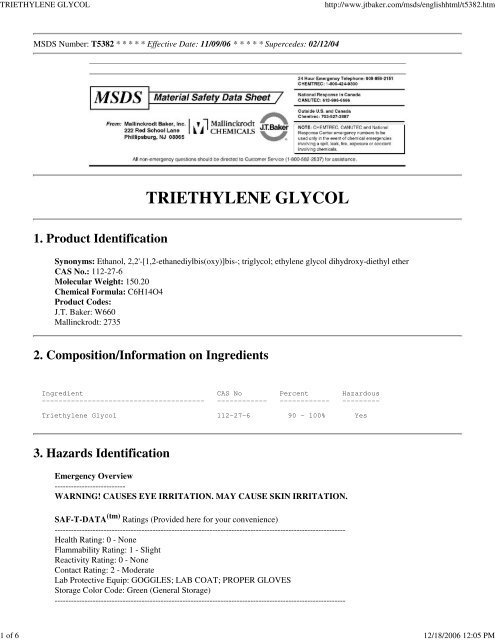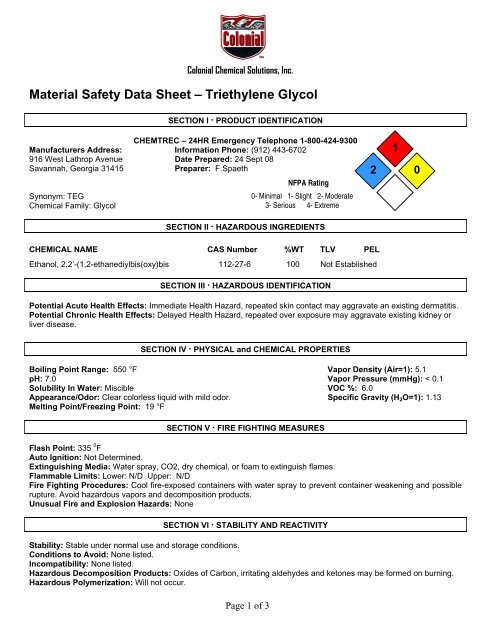Triethylene glycol hazard
Home » chemical » Triethylene glycol hazard >Triethylene glycol hazard
Triethylene Glycol Hazard. Propylene Glycol from Renewable Resources abstract Richland WA. 2 100 Acute Tox. 2012 No Verdezyne Inc. Select Scenario Resident Indoor Worker Outdoor Worker Composite Worker presented in Generic Tables Construction Worker Site Specific only Fish Site Specific Only Soil to Groundwater Recreator Site Specific only Select Media.

Das eingeschlossene Methan stammt vorwiegend aus der. European Chemicals Agency ECHA 1012 Hazard Classes and Categories. Universal pH Indicator Solution SDS. DEG is a widely used solvent. Zinc Sulfate Monohydrate SDS. Zinc Chloride 50 wv Technical Grade SDS.
Date Created 642015 Date Updated 642015 Item Number Limitations of Warranty.
Es ist aus Wassermolekülen aufgebaut die über Wasserstoffbrückenbindungen eine Käfigstruktur bilden in denen Methanmoleküle eingeschlossen sind. SELLER MAKES NO OTHER WARRANTY WHETHER EXPRESSED OR IMPLIED INCLUDING WARRANTIES OF. Hazard communication training required by sections 5191 or 5194 shall address these health hazards and symptoms along with the measures taken by the employer to evaluate and control exposures that can include medical evaluations exposure monitoring ventilation systems work practices and personal protective equipment. Incineration preferably after mixing with another combusti- ble fuel. Triethylene Glycol Monobutyl Ether 143-22-6 5-50 Tetrathylene Glycol Monobutyl Ether 1559-34-8 5-20 Polyethylene Glycol 25322-68-3 5-20 Diethylene Glycol Monobutyl Ether 112-34-5 5-20 Diethylene Glycol 111-46-6 5-15 Diethylene Glycol Monomethyl Ether 111-77-3. This has resulted in.
 Source: hclco.com
Source: hclco.com
Zinc Sulfate Monohydrate SDS. Xylene INORGANIC Inorganic. Containing two alcohol groups it is classed as a diolIt is miscible with a broad range of solvents including water acetone and chloroformIn general glycols are non-irritating and have very low volatility. Triethylene Glycol Technical Data. The researchers concluded that the water vapour permeability of the membranes increased with increasing amounts of the hygroscopic component LiCl or TEG because it lowered the diffusion energy and thus the barrier to permeation.
 Source: centurygraphics.blogspot.com
Source: centurygraphics.blogspot.com
2A 100 European Chemicals Agency ECHA Skin Irrit. Only hazard codes with percentage values above 10 are shown. It can be a contaminant in consumer products. Diethylene glycol DEG is an organic compound with the formula HOCH 2 CH 2 2 O. Mono- and di- ethers of ethylene glycol diethylene glycol and triethylene glycol R-OCH2CH2n-OR where n 1 2 or 3 R alkyl or aryl groups R R h or groups which when removed yield glycol ethers with the structure R-OCH2CH2n-OH.

Hazard communication training required by sections 5191 or 5194 shall address these health hazards and symptoms along with the measures taken by the employer to evaluate and control exposures that can include medical evaluations exposure monitoring ventilation systems work practices and personal protective equipment. Propylene glycol is used by the chemical food and pharmaceutical industries as an antifreeze when leakage might lead to contact with food. The communication system required by section 3203 shall inform employees. 2012 No Verdezyne Inc. Xerographic Dry Ink Resin Manufacturing Hazard Emission Reduction abstract.
 Source: yumpu.com
Source: yumpu.com
The use of chemical sprays such as triethylene glycol to clean the air in an occupied space has a limited evidence base in beingeffective in reducing airborne virus transmission risks and has potential health effects for those exposed over a long period of time medium confidence. Triethylene Glycol Technical Data. It is a colorless practically odorless poisonous and hygroscopic liquid with a sweetish taste. It can be a contaminant in consumer products. By default the eCFR is displayed with paragraphs split and indented to follow the hierarchy of the document Enhanced Display.
 Source: hclco.com
Source: hclco.com
1 100 Eye Irrit. 2 100 Resp. This is an automated process for user convenience only and is not intended to alter agency intent or existing codification. By default the eCFR is displayed with paragraphs split and indented to follow the hierarchy of the document Enhanced Display. Biobased Adipic Acid for Renewable Nylon and Polyurethane Resins abstract Carlsbad CA.
Source:
1 100 Eye Irrit. Triethylene glycol β. The Institute comprises 33 Full and 14 Associate Members with 16 Affiliate Members from departments within the University of Cape Town and 17 Adjunct Members based nationally or internationally. Xylene INORGANIC Inorganic. The Food and Drug Administration FDA.
 Source: yumpu.com
Source: yumpu.com
Target Organ Effect Harmful by ingestion Irritant Teratogen Reproductive hazard. Triethylene glycol Undecanol Group 7. Xerographic Dry Ink Resin Manufacturing Hazard Emission Reduction abstract. Care must be taken to assure complete combustion to prevent the formation of phosgene. Xylene INORGANIC Inorganic.

Xerographic Dry Ink Resin Manufacturing Hazard Emission Reduction abstract. Very hazardous in case of eye contact irritant of ingestion. 2012 No Verenium Corporation Pyrolase Cellulase Enzyme Breaker as a Biodegradable Replacement for Corrosive Acids and. HAZARDS IDENTIFICATION Potential Acute Health Effects. Propylene glycol is used by the chemical food and pharmaceutical industries as an antifreeze when leakage might lead to contact with food.

Propylene glycol is used by the chemical food and pharmaceutical industries as an antifreeze when leakage might lead to contact with food. Propylene Glycol from Renewable Resources abstract Richland WA. Es ist aus Wassermolekülen aufgebaut die über Wasserstoffbrückenbindungen eine Käfigstruktur bilden in denen Methanmoleküle eingeschlossen sind. SELLER MAKES NO OTHER WARRANTY WHETHER EXPRESSED OR IMPLIED INCLUDING WARRANTIES OF. This has resulted in.
Source:
The Food and Drug Administration FDA. Only hazard codes with percentage values above 10 are shown. The use of chemical sprays such as triethylene glycol to clean the air in an occupied space has a limited evidence base in beingeffective in reducing airborne virus transmission risks and has potential health effects for those exposed over a long period of time medium confidence. Triethylene Glycol Monobutyl Ether 143-22-6 5-50 Tetrathylene Glycol Monobutyl Ether 1559-34-8 5-20 Polyethylene Glycol 25322-68-3 5-20 Diethylene Glycol Monobutyl Ether 112-34-5 5-20 Diethylene Glycol 111-46-6 5-15 Diethylene Glycol Monomethyl Ether 111-77-3. Hazard Communication Standard also known as the Right to Know Law 29 CFR 19101200 requires that employees are informed of potential work hazards and trained on associated safe practices procedures and protective measures.
If you find this site helpful, please support us by sharing this posts to your own social media accounts like Facebook, Instagram and so on or you can also save this blog page with the title triethylene glycol hazard by using Ctrl + D for devices a laptop with a Windows operating system or Command + D for laptops with an Apple operating system. If you use a smartphone, you can also use the drawer menu of the browser you are using. Whether it’s a Windows, Mac, iOS or Android operating system, you will still be able to bookmark this website.